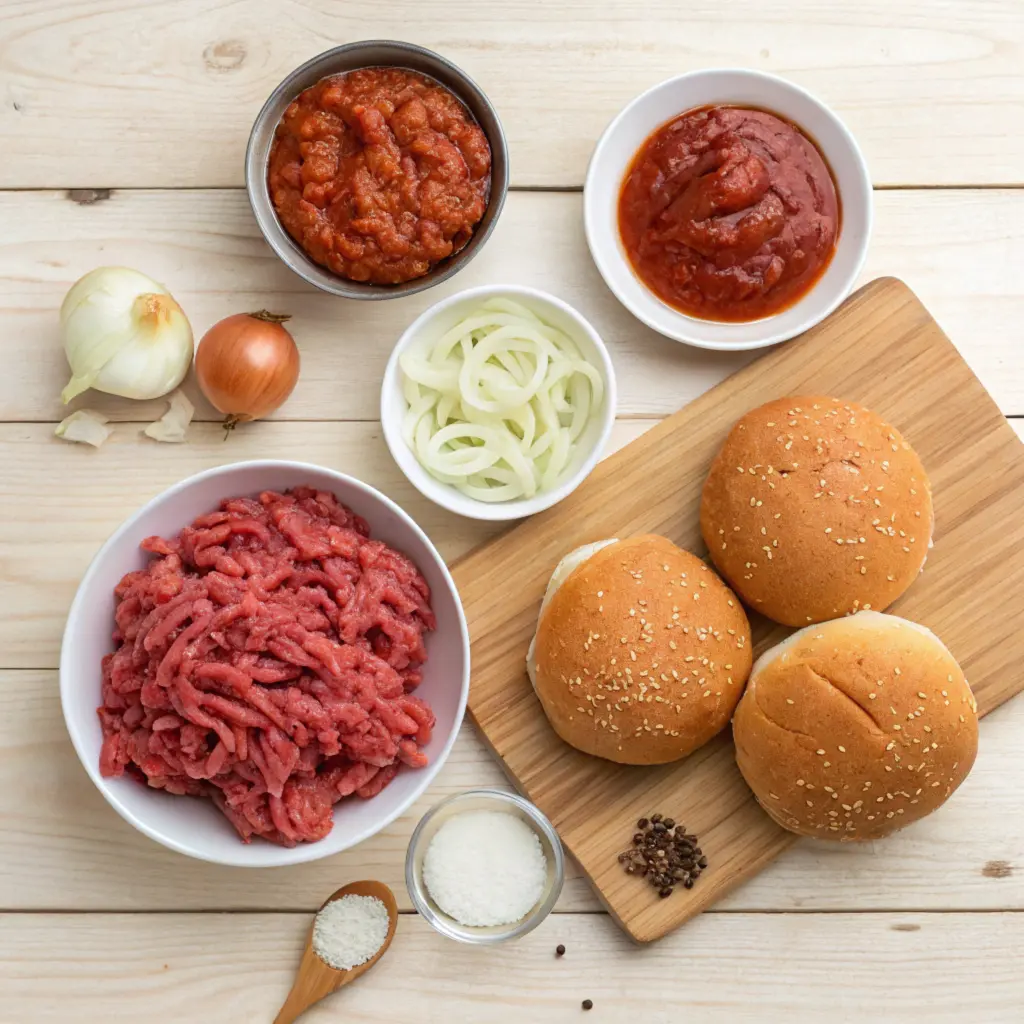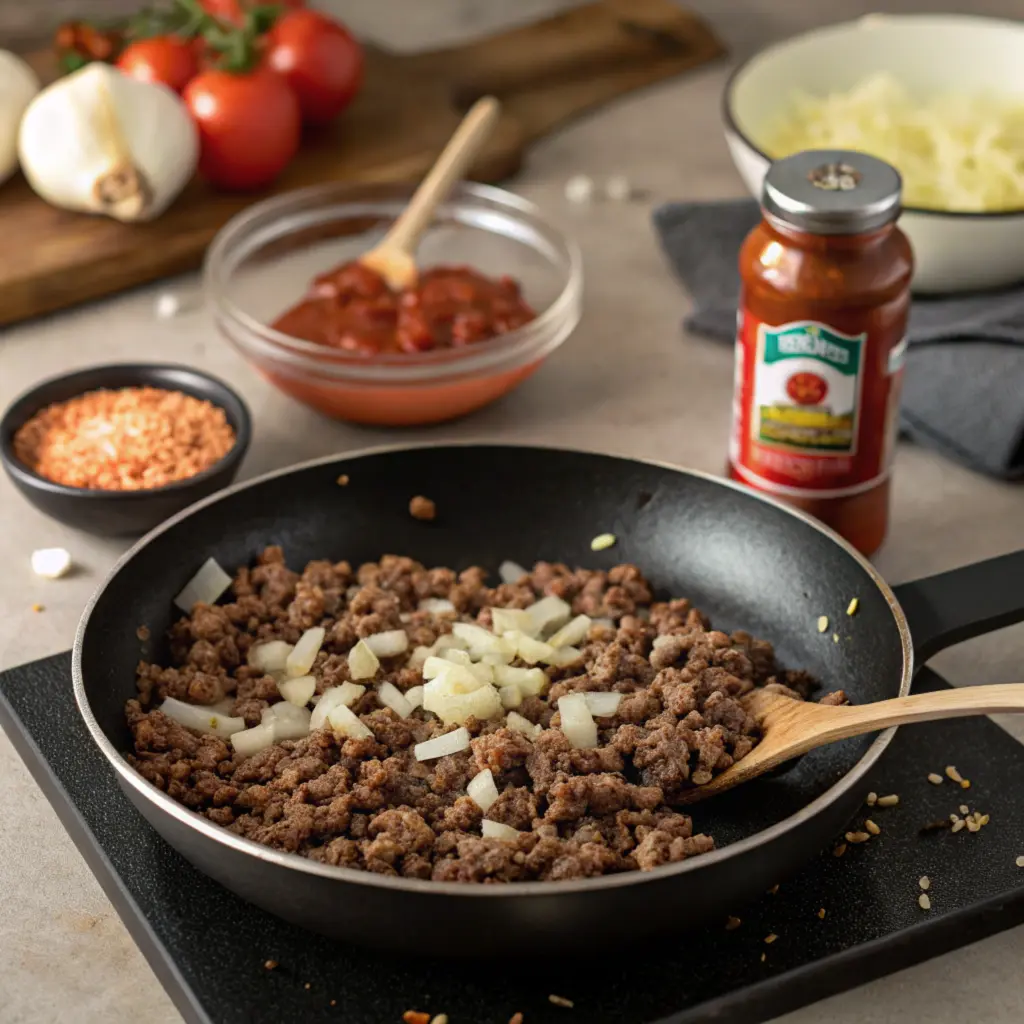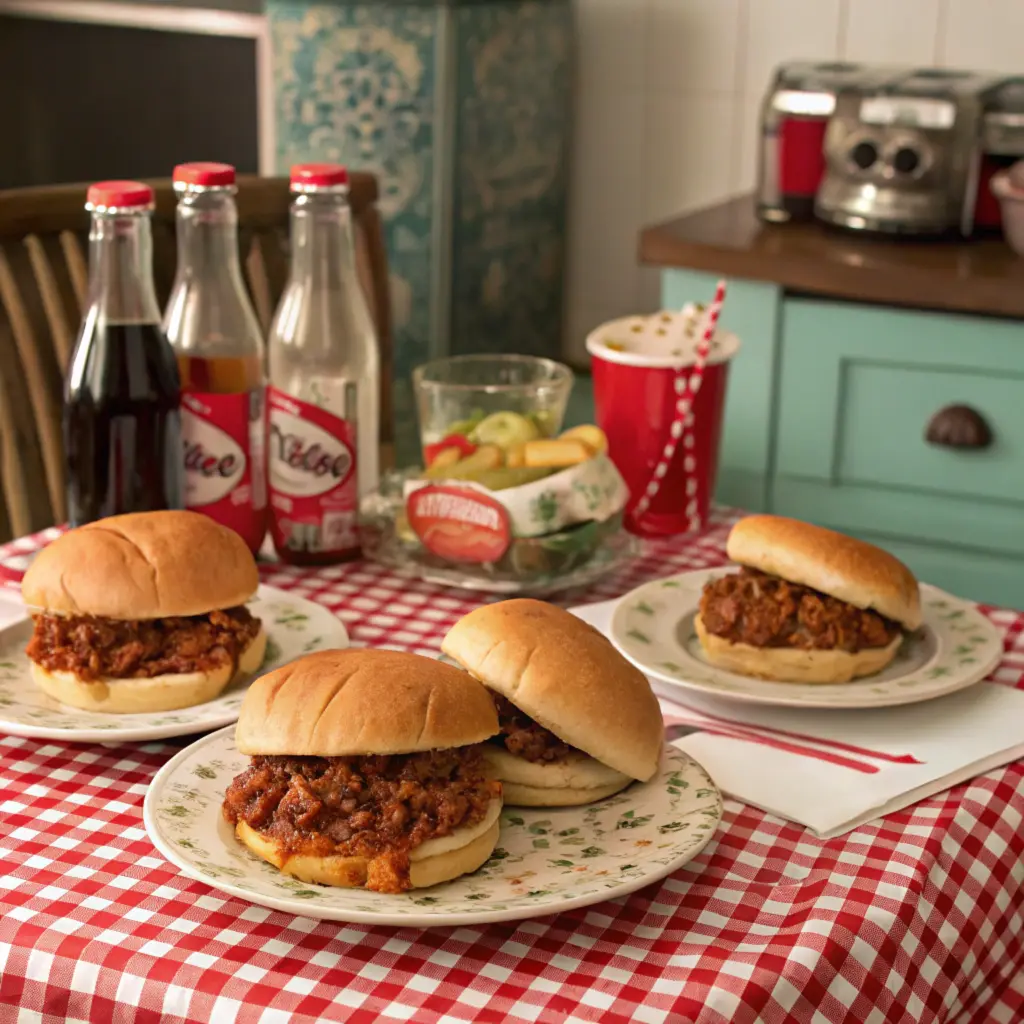When you think of classic American comfort foods, the original sloppy joe often springs to mind. This beloved sandwich, messy yet satisfying, conjures up images of school lunches, casual family dinners, and large, comforting gatherings. However, many home cooks wonder: what was the original sloppy joe made with? To answer that, we must journey back in time and explore its early origins. Therefore, this article will explain its traditional ingredients, trace its fascinating history, and offer tips for preparing your own authentic version at home.
Uncovering the Roots of the Original Sloppy Joe
Most food historians believe that the original sloppy joe emerged during the early 20th century. In fact, some culinary experts suggest that a short-order cook named Joe, hailing from Sioux City, Iowa, created the first sloppy version of a ground beef sandwich. This early version was a loose mixture of seasoned ground beef simmered in a lightly spiced, tomato-based sauce. However, the exact details remain somewhat elusive, and several regions claim credit for inventing the dish.
In addition, various sources offer intriguing insights into the sandwich’s evolution. For example, you can learn more about early American sandwiches at Smithsonian Magazine. This resource provides context on the cultural trends that influenced American comfort foods. Furthermore, to understand how modern cooking techniques have shaped the dish’s evolution, consider reading about culinary traditions at The Spruce Eats. They provide detailed explanations and ingredient guides that may help decode the original sloppy joe’s early recipes.
Moreover, the global exchange of flavors and cooking methods influenced the original sloppy joe over time. For comprehensive information on classic American sandwiches and their cultural significance, you may consult History.com for broad historical perspectives. These external resources illustrate how food traditions merge and evolve, helping us grasp the original sloppy joe’s place in American culinary heritage.
The Basic Components of the Original Sloppy Joe
The key to understanding what the original sloppy joe was made with lies in its simplicity. Early recipes did not rely on processed mixes, bottled sauces, or exotic spices. Instead, they included a handful of straightforward ingredients.
Traditional Ingredients:
- Ground beef: The foundation of the original sloppy joe is well-browned, crumbled ground beef.
- Onions: Finely chopped onions provide a sweet, aromatic depth.
- Tomato sauce or tomato paste: A rich tomato base gives the sandwich its distinct, tangy flavor.
- Mild seasonings: Early versions kept it simple, often just salt, pepper, and maybe a splash of Worcestershire sauce.
- Soft bread roll: A fluffy, white hamburger bun cradled this savory mixture.
While modern versions sometimes add bell peppers, garlic, sugar, and other seasonings, the original sloppy joe focused on balance and affordability. Therefore, this minimalist approach allowed the meat’s natural flavor to shine.
The Evolution of the Original Sloppy Joe
Over the decades, the original sloppy joe has evolved, reflecting shifts in American taste and cuisine. Therefore, modern adaptations now include a wide range of flavors and cultural influences. However, these new twists never stray too far from the original’s comforting, home-style appeal.
For example, some cooks introduce mustard, ketchup, or barbecue sauce to create a sweeter, tangier flavor. In addition, others opt for ground turkey or even plant-based meat alternatives to cater to dietary needs. This evolution shows how the original sloppy joe can easily adapt to modern times, making it a flexible option for contemporary dinners and gatherings.
Cooking the Original Sloppy Joe at Home
Ingredients (Serves 4 to 6):
- 1 ½ pounds ground beef (80/20 lean-to-fat ratio for flavor)
- 1 medium onion, finely chopped
- 1 small can tomato sauce (8 oz) or tomato paste (adjusting liquid accordingly)
- 1 cup water or low-sodium beef broth (if using paste, to thin the sauce)
- 1 tablespoon Worcestershire sauce
- Salt and pepper to taste
- 4 to 6 soft hamburger buns

Instructions:
- Brown the Beef:
Heat a large skillet over medium-high heat. Add the ground beef and cook, breaking it apart with a wooden spoon. Therefore, ensure even browning. Drain excess fat if needed. - Add the Onions:
Stir in the chopped onions and continue cooking until they soften. This step provides natural sweetness. - Incorporate the Sauce:
Add the tomato sauce (or paste plus water or broth) and Worcestershire sauce. Therefore, stir well to combine. Season with salt and pepper. - Simmer and Adjust:
Lower the heat and let the mixture simmer for about 10-15 minutes. Stir occasionally to prevent sticking. Add more water if needed. - Taste and Serve:
Taste and adjust seasonings as desired. Spoon the mixture onto soft hamburger buns. Serve hot.

This basic preparation closely resembles what the original sloppy joe was made with, bringing you closer to that authentic, old-fashioned experience.
Why Simplicity Matters
The original sloppy joe thrived because it delivered maximum flavor with minimal fuss. In a time when convenience mattered, this sandwich offered a quick and affordable meal for busy families. Therefore, the simplicity of these early recipes contributed to their widespread popularity.
In addition, limiting the ingredients ensures that each flavor stands out. The rich, savory essence of beef contrasts with the tangy tomato sauce and the subtle sweetness of onions. This harmonious blend defined the original sloppy joe.
Cultural Significance of the Original Sloppy Joe
The original sloppy joe reflects a chapter in American culinary history when the nation embraced hearty, low-cost meals. During difficult economic times, affordable dishes boosted morale and nourished households. Therefore, the sloppy joe’s success rested on its ability to stretch meat and feed many people with few ingredients.
In addition, its popularity soared as diners, school cafeterias, and home kitchens served this messy but delicious staple. Over time, the original sloppy joe became a symbol of communal gatherings, family celebrations, and casual cookouts. Therefore, it now holds a special place in the hearts of countless Americans.
Common Variations That Emerged
Over the years, cooks began adding personal touches. However, these variations still echo the essence of the original sloppy joe. For example:
- Green peppers: They add sweetness and subtle crunch.
- Garlic and spices: Some cooks include garlic powder, paprika, or chili flakes to deepen flavor.
- Sugar or molasses: A small spoonful of sweetener balances the tangy tomato sauce.
- Different proteins: Ground turkey, chicken, pork, or plant-based crumbles offer lighter or meat-free options.
These adaptations keep the concept fresh while preserving the comforting, familiar soul of the sloppy joe.
Modern Cooking Methods: Slow Cooker and Instant Pot
While the earliest sloppy joes simmered on a stovetop, modern kitchen appliances offer convenience. Therefore, you can use a slow cooker or an Instant Pot to create a low-effort meal.
Slow Cooker Method:
- Brown the beef and onions on the stove.
- Transfer to a slow cooker and add tomato sauce, Worcestershire sauce, and seasonings.
- Cook on low for 4-6 hours.
- Stir occasionally and adjust liquid levels if needed.
This method, inspired by the original sloppy joe approach, frees you to tend to other tasks.
Instant Pot Method:
- Use the sauté function to brown the beef and onions.
- Add the tomato sauce, seasonings, and a bit of water.
- Lock the lid and pressure cook for a few minutes.
- Release pressure and adjust seasonings.
In addition, these methods produce the same rich flavor with less active time.
Serving Suggestions and Pairings
The original sloppy joe pairs well with many sides, making it a versatile meal. Consider these suggestions:
- Classic sides: Fries, tater tots, or potato salad.
- Healthier options: A simple green salad or roasted vegetables.
- Bread alternatives: Serve sloppy joe mixture over baked potatoes or use whole-grain buns.
In addition, the savory, saucy meat mixture contrasts beautifully with crunchy slaw or a tangy pickle. Therefore, choose sides that complement the rich flavors and soft textures of the sandwich.
Adapting the Original Sloppy Joe for Special Diets
While the original sloppy joe relied on ground beef, you can adapt it to suit various dietary needs. Therefore, consider these options:
- Vegetarian: Use lentils, beans, or plant-based meat substitutes.
- Gluten-free: Serve over rice, gluten-free buns, or sweet potatoes.
- Low-carb: Skip the bun and serve in lettuce wraps.
In addition, these adjustments maintain the comforting essence while broadening its appeal.
Storing and Reheating Leftovers
Leftover sloppy joe filling keeps well in the refrigerator for several days. Therefore, you can make it ahead for busy weeknights.
Storage Tips:
- Cool the mixture before transferring it to an airtight container.
- Refrigerate for up to 3-4 days.
- Freeze for longer storage, up to three months.
Reheating Instructions:
- Gently warm in a saucepan over medium heat.
- Add a splash of water or broth if it seems too thick.
- Stir occasionally and serve hot.
In addition, this straightforward approach ensures your original sloppy joe remains just as delicious the next day.
Health Considerations and Nutritional Profile
The original sloppy joe is a meat-based dish with a moderate calorie count. Ground beef provides protein, iron, and B vitamins. However, to make it healthier, choose leaner ground meats, add vegetables, and serve with nutritious sides.
In addition, replacing some of the meat with lentils or beans boosts fiber and reduces saturated fat. Therefore, small changes can increase the dish’s nutritional value without sacrificing taste.
The Original Sloppy Joe in Popular Culture
The original sloppy joe has made appearances in movies, television shows, and even literature. Its messy nature provides a visual cue for comfort and casual dining. Therefore, its cultural relevance goes beyond the kitchen.
In addition, this sandwich symbolizes home-style cooking and nostalgia. Many Americans remember it from childhood dinners or community events. Therefore, the sloppy joe remains a cherished symbol of simplicity and warmth.
Expert Tips for Perfecting Your Original Sloppy Joe
Achieving the best flavor requires attention to detail. Therefore, consider these tips:
- Quality meat: Opt for ground beef with enough fat to ensure juiciness.
- Season early: Salt and pepper the meat as it cooks.
- Balance flavors: Taste and adjust seasoning as the mixture simmers.
- Use good buns: Soft, fresh hamburger buns enhance the final experience.
In addition, experimenting with small changes helps you personalize the dish while preserving its timeless appeal.
Incorporating the Original Sloppy Joe Into Weekly Meal Plans
This classic dish fits well into meal rotations because it’s easy and affordable. Therefore, consider it for a quick weeknight dinner.
Meal Planning Ideas:
- Make a large batch on Sunday and freeze portions.
- Use leftovers as a topping for baked potatoes or nachos.
- Serve it for casual gatherings alongside other comfort foods.
In addition, the original sloppy joe stands as a versatile staple that suits many dining occasions.
Tips for Hosting a Retro-Themed Dinner Party
The original sloppy joe shines at events that celebrate classic American comfort foods. Therefore, consider a 1950s-inspired dinner party with checkered tablecloths and old-fashioned soda bottles.
Suggestions:
- Offer a build-your-own sloppy joe bar with various toppings.
- Serve vintage sides like deviled eggs and Jell-O salad.
- Play music from the era and encourage guests to dress in period attire.
In addition, these touches transport guests to a simpler time and highlight the nostalgia of the original sloppy joe.

Exploring Regional Twists
Some regions have their own take on the original sloppy joe. For example, New Jersey’s “Sloppy Joe” is a cold deli sandwich with coleslaw and Russian dressing. However, this variation differs dramatically from the hot, saucy mixture we know.
In addition, some Midwestern states feature versions closer to the original. They might add mustard or pickles to enhance flavor. Therefore, exploring local specialties reveals how geography shapes culinary interpretations.
The Economic and Historical Context
The original sloppy joe emerged during decades when cheap, filling meals mattered. In addition, it might have gained popularity during the Great Depression, when simple, hearty dishes became essential.
Therefore, understanding its historical context helps us appreciate why it resonates with so many. It represents resourcefulness and creativity in the kitchen.
Sustainability Considerations
In today’s world, sustainability matters. Therefore, consider eco-friendly options:
- Choose locally sourced, grass-fed beef.
- Incorporate more plant-based ingredients.
- Use seasonal produce and reduce food waste.
In addition, these choices align with modern values while preserving the essence of the original sloppy joe.
Pairing Beverages with the Original Sloppy Joe
Beverage choices can elevate your meal. Therefore, consider pairing your sloppy joe with:
- Soft drinks: Classic colas or root beer enhance the retro feel.
- Beer: A light lager or amber ale complements the savory flavors.
- Iced tea: A refreshing, non-alcoholic option that balances richness.
In addition, experimenting with different beverages can create a more complete dining experience.
Preserving Tradition While Embracing Change
The original sloppy joe endures because it merges tradition and adaptability. Therefore, you can keep its historical roots alive by using classic ingredients. At the same time, you can adapt it to fit modern tastes and dietary needs.
In addition, you can share stories about its origins with younger generations. This ensures the sandwich remains part of our collective culinary memory.
Importance of Texture in the Original Sloppy Joe
Texture matters as much as flavor. Therefore, the tender, saucy meat contrasts beautifully with a soft bun. In addition, adding crisp toppings like pickles or onions can provide more dimension.
Focus on consistency as you cook. A too-dry mixture won’t taste as comforting, while a sauce too thin can soak the bun. Therefore, adjust the liquid to achieve the right balance.
Presentation Tips
The original sloppy joe may be messy, but you can still present it attractively. Therefore:
- Use a sturdy plate and provide napkins.
- Garnish with fresh herbs like parsley or chives.
- Serve with colorful sides for visual contrast.
In addition, thoughtful presentation turns a humble dish into a memorable meal.
The Original Sloppy Joe in Restaurants
While homemade versions prevail, some diners and casual eateries serve a classic rendition. Therefore, if you encounter a sloppy joe on a menu, consider ordering it. You might discover a nostalgic flavor that transports you back in time.
In addition, some restaurants experiment with gourmet versions, adding artisanal buns or unique condiments. While these twists differ from the original sloppy joe, they keep the concept fresh and relevant.
Encouraging Culinary Curiosity
Exploring the original sloppy joe can inspire curiosity. Therefore, consider researching other vintage dishes to understand how American cuisine evolved. In addition, learning about food history can deepen your appreciation for everyday meals.
As you cook and share the original sloppy joe, encourage others to try new recipes and experiment with flavors.
Embracing Imperfection
A key charm of the original sloppy joe is its messy nature. Therefore, embrace the drips and spills. This dish stands as a reminder that great food doesn’t need to be perfect.
In addition, imperfection often leads to comfort, laughter, and memorable meals. So celebrate the casual, hands-on experience that defines the sloppy joe tradition.
Looking to the Future
As culinary trends shift, the original sloppy joe remains a foundation for innovation. Therefore, expect chefs and home cooks to keep experimenting. They might add global spices or unusual toppings.
In addition, plant-based options and healthier versions will continue to emerge. The flexibility and adaptability of this dish ensure it will thrive for generations.
Frequently Asked Questions (FAQs)
1. What is the difference between a sloppy joe and a Manwich?
A sloppy joe is usually made from scratch with basic ingredients like ground beef, onions, and tomato sauce. A Manwich is a brand of canned sauce designed for convenience, allowing you to create a similar sandwich with less prep work.
2. How can I thicken my sloppy joe mixture?
Simmering the mixture longer helps reduce excess liquid. In addition, you can add a small amount of cornstarch mixed with water. Stir until it reaches your desired consistency.
3. Is the sloppy joe originally from Cuba?
Although there is a bar in Havana called “Sloppy Joe’s,” the original sloppy joe as known in the United States differs. The Cuban version influenced the name but not the exact recipe of the American sloppy joe.
4. What side dishes go well with sloppy joes?
Classic sides like coleslaw, potato chips, or baked beans pair well. In addition, a fresh green salad, roasted vegetables, or a light fruit salad can provide balance.
5. Can I make a vegetarian version of the sloppy joe?
Yes, you can use lentils, beans, or plant-based meat alternatives. Therefore, you maintain the texture and savory flavor while skipping the meat.
Conclusion
The original sloppy joe is more than just a sandwich; it’s a piece of American culinary history that has stood the test of time. With its humble origins, simple ingredients, and comforting flavors, this dish embodies the essence of hearty, home-cooked meals. Whether you’re recreating the classic recipe, exploring modern variations, or hosting a retro-themed dinner party, the sloppy joe remains a versatile and beloved staple.
By understanding its history and embracing its adaptability, you can keep the original sloppy joe tradition alive while making it your own. So, roll up your sleeves, enjoy the messy goodness, and share this timeless comfort food with friends and family.

